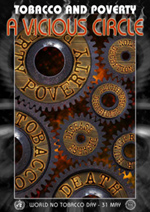The Tobacco Free Initiative proposes that World No Tobacco Day 2004 focus on tobacco and poverty.
The contribution of tobacco to death and disease is well documented. Less attention is given to the ways in which tobacco increases poverty.
Tobacco is the fourth most common risk factor for disease worldwide. The economic costs of tobacco use are equally devastating. In addition to the high public health costs of treating tobacco-caused diseases, tobacco kills people at the height of their productivity, depriving families of breadwinners and nations of a healthy workforce. Tobacco users are also less productive while they are alive due to increased sickness. A 1994 report estimated that the use of tobacco resulted in an annual global net loss of US$ 200 thousand million, a third of this loss being in developing countries.
Tobacco and poverty
Developing countries will face the brunt of the tobacco epidemic. Although tobacco use has declined in many high-income countries in recent decades, there have been sharp increases in tobacco use, especially among men, in low and middle-income countries in recent years. Close to 60% of the 5.700 billion cigarettes smoked each year and 75% of tobacco users are in developing countries. This in itself justifies investments in comprehensive tobacco control programmes. It is, however, important to note that tobacco use and its associated burden of disease, tends to follow a gradient. In other words, poorer individuals tend to use tobacco products more than their wealthier counterparts. Similar patterns exist with respect to education and socioeconomic status.
The contribution of tobacco to death and disease is well documented. Less attention is given to the ways in which tobacco increases poverty. This is the damage that is done when scarce family resources are spent on tobacco products instead of food and other essential needs such as schooling and nutrition. The money that poor households spend on tobacco products (between 4 to 5 % of all their disposable income) has very high opportunity costs, diverting scarce resources away from food and other basic needs. For example, in China, individuals with no schooling were 6.9 times more likely to smoke than individuals with a college degree while uneducated adults in Brazil were five times more likely to smoke than adults who had received at least a second degree.

The proportion of household expenditures used to purchase tobacco products is often very high in developing countries. For example, if two-thirds of the money spent on cigarettes in Bangladesh were spent on food instead, it could save more than 10 million people from malnutrition. New research in India found that tobacco use is associated with worse nutrition and child health outcomes. In Bulgaria, low-income households with at least one smoker spent 10.4% of their total income on tobacco products in 1995. In China, smokers surveyed in the Minhang district reported spending 17% of their household income on cigarettes. Along with countries, development agencies, donors and multilateral agencies too are recognizing that tobacco use has implications for poverty that go far beyond the health implications. In a 1999 report, Curbing the Epidemic, Governments and the Economics of Tobacco Control, the World Bank explored the economic dimensions that must be addressed as nations embark on the road to comprehensive tobacco control. That report systematically and scientifically demolished doomsday scenarios of economic loss that have deterred policy-makers from taking action. Policies that reduce the demand for tobacco, such as a decision to increase tobacco taxes, would not cause long-term job losses in the vast majority of countries, nor would higher tobacco taxes reduce tax revenues; rather, revenues would climb in the medium term. Such policies could, in sum, bring health benefits without harming economies.
Tobacco growing harms the environment. It leads to the degradation of the environment caused by the tobacco plant leaching nutrients from the soil, pollution from pesticides and fertilizers and deforestation as a result of the fire curing of some common varieties of tobacco. A recent study that assessed the amount of forest and woodland consumed annually for curing tobacco concluded that nearly 5% of overall deforestation in respective growing countries was due to tobacco cultivation. Child labour is another critical issue. In the late 1990’s, UNICEF concluded that use of children in tobacco production was widespread in many tobacco-producing countries.
World No Tobacco Day 2004 will bring out the poverty-causing, poverty-sustaining and exploitative labour practices.
For more information contact the WHO Web Site:
http://www.who.int/tobacco/areas/communications/events/wntd/2004/en/

